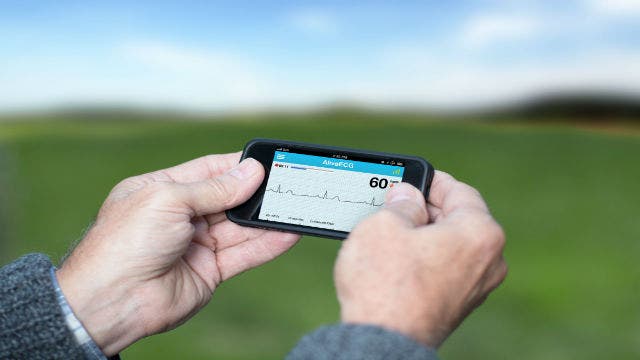Real-time ECG from your fingertips
Today, apps can perform an array of medical tests; analyzing anything from blood to saliva, and even urine. Dr. Kevin Campbell fills us in on new technology that can turn your phone into a mobile heart monitor
Smartphones and apps are commonplace, but they’re not just for our entertainment— they can be important tools to help manage healthcare. While there are many regulatory challenges with mass market medical smartphone applications, the benefits for patients can be enormous. Moreover, if simple, low-cost software programs can help patients better manage their disease at home and avoid costly hospital admissions and ER visits, the financial impact on the struggling U.S. healthcare system could be substantial.
A new device and application created by Dr. Dave Albert and AliveCor, has recently been cleared by the Food and Drug Administration (FDA) for sale without a physicians’ prescription. The AliveCor Device allows patients to obtain a real-time single lead electrocardiogram (ECG) from their fingertips using their own smartphone.
The device uses electrodes embedded into a standard phone case to measure electrical signals in the fingertips. These signals are then transmitted via the phone’s microphone to the AliveCor app on the patient’s phone.
This device then allows the patient to record, share and upload their ECG tracing for analysis by their physicians and other healthcare providers. The ability to obtain a real-time ECG is essential to the treatment of heart rhythm disorders and can also help patients and physicians adjust therapy and improve care. The application associated with the device is able to assimilate the ECG data and allows a patient to create a PDF file that can be stored and even emailed to their physician. If desired, the application will also upload the file to a secure "cloud" for analysis by the ALiveCor staff.
The AliveCor device has many practical applications for patients, including monitoring heart rhythm during periods of symptoms. This correlation of real-time heart rhythm with symptoms is often the critical step in helping physicians make a diagnosis and can readily determine if the symptoms are in fact related to a heart rhythm disorder at all.
In addition, the application can help patients avoid costly and time-consuming emergency room visits when they experience certain symptoms such as palpitations or lightheadedness. Instead of rushing to the ER, a patient can record his heart rhythm with the device, transmit the tracing to his provider and, in many cases, receive reassurance right away. In the case of patients with a previously diagnosed heart rhythm disorder such as atrial fibrillation, the device is an excellent way to help monitor response to therapy between visits to their healthcare provider.
As more health-related applications are developed, it is likely that there will be regulatory challenges. As medical application “prescriptions” are initiated by providers, there will be more significant FDA involvement. Certainly an application designed for patient care and disease management must be “bug free.”
However, I believe that there is a huge upside to smartphone applications in medical care. Increasingly, physicians are under pressure to see more patients in less time. As more data is made available to both physician and patient, the task of properly evaluating the patient and managing the data– and ultimately the patient’s presenting complaint and chronic disease– in the office becomes even more daunting.
Smartphones have the capability of collecting and organizing data that can be of use to both patient and physician. Simple tasks like tracking medication use and compliance, monitoring blood pressure or blood sugars can improve a provider’s ability to effectively and efficiently manage a chronic disease. Furthermore, having a patient input or transfer data to and from their smartphone engages the patient in their own care– thus improving outcomes. We know that patient engagement in care is critical to successful disease management.
Imagine the cost savings impact technology can have for health care— and a patient’s life. If, for example, a patient with diabetes is able to track changes or patterns in blood sugar levels and correlate them with particular behaviors, a phone call or electronic communication with his or her physician may prevent a hospital admission or clinic visit.
To me, using smartphones to manage medical data and impact disease is more than an exciting science fiction story, it’s reality. As a society, we have embraced smartphone use in nearly every aspect of our daily lives. Now is the time for physicians, patients and the government regulatory leaders to act. Let’s take advantage of what technology has to offer and provide patients and physicians with the tools they need to expedite care and improve outcomes.
Dr. Kevin Campbell is an assistant professor of medicine in the division of cardiology at University of North Carolina at Chapel Hill. For more from Dr. Campbell, visit his website DrKevinCampbellMD.com.





















